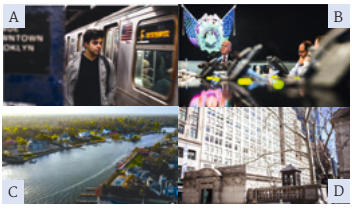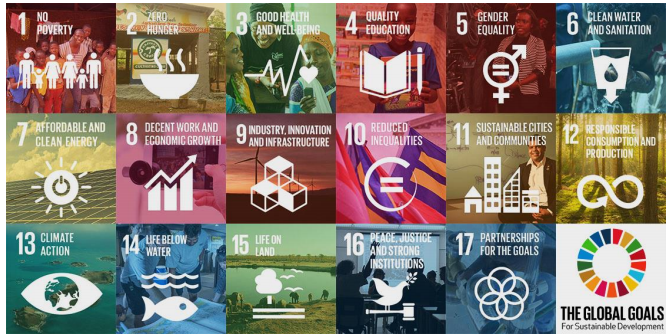Questões de Vestibular
Comentadas sobre interpretação de texto | reading comprehension em inglês
Foram encontradas 680 questões
Leia o texto para responder à questão.
America’s social-media addiction is getting worse

(Sources: Pew Research Centre; e Marketer)
A survey in January and February 2019 from the Pew Research Centre, a think tank, found that 69% of American adults use Facebook; of these users, more than half visit the site “several times a day”. YouTube is even more popular, with 73% of adults saying they watch videos on the platform. For those aged 18 to 24, the figure is 90%. Instagram, a photo-sharing app, is used by 37% of adults. When Pew first conducted the survey in 2012, only a slim majority of Americans used Facebook. Fewer than one in ten had an Instagram account.
Americans are also spending more time than ever on social-media sites like Facebook. There is evidence that limiting such services might yield health benefits. A paper published last year by Melissa Hunt, Rachel Marx, Courtney Lipson and Jordyn Young, all of the University of Pennsylvania, found that limiting social-media usage to 10 minutes a day led to reductions in loneliness, depression, anxiety and fear. Another paper from 2014 identified a link between heavy social-media usage and depression, largely due to a “social comparison” phenomenon, whereby users compare themselves to others and come away with lower evaluations of themselves.
(www.economist.com, 08.08.2019. Adaptado.)
Leia o texto para responder à questão.
America’s social-media addiction is getting worse

(Sources: Pew Research Centre; e Marketer)
A survey in January and February 2019 from the Pew Research Centre, a think tank, found that 69% of American adults use Facebook; of these users, more than half visit the site “several times a day”. YouTube is even more popular, with 73% of adults saying they watch videos on the platform. For those aged 18 to 24, the figure is 90%. Instagram, a photo-sharing app, is used by 37% of adults. When Pew first conducted the survey in 2012, only a slim majority of Americans used Facebook. Fewer than one in ten had an Instagram account.
Americans are also spending more time than ever on social-media sites like Facebook. There is evidence that limiting such services might yield health benefits. A paper published last year by Melissa Hunt, Rachel Marx, Courtney Lipson and Jordyn Young, all of the University of Pennsylvania, found that limiting social-media usage to 10 minutes a day led to reductions in loneliness, depression, anxiety and fear. Another paper from 2014 identified a link between heavy social-media usage and depression, largely due to a “social comparison” phenomenon, whereby users compare themselves to others and come away with lower evaluations of themselves.
(www.economist.com, 08.08.2019. Adaptado.)
Leia o texto para responder à questão.
America’s social-media addiction is getting worse

(Sources: Pew Research Centre; e Marketer)
A survey in January and February 2019 from the Pew Research Centre, a think tank, found that 69% of American adults use Facebook; of these users, more than half visit the site “several times a day”. YouTube is even more popular, with 73% of adults saying they watch videos on the platform. For those aged 18 to 24, the figure is 90%. Instagram, a photo-sharing app, is used by 37% of adults. When Pew first conducted the survey in 2012, only a slim majority of Americans used Facebook. Fewer than one in ten had an Instagram account.
Americans are also spending more time than ever on social-media sites like Facebook. There is evidence that limiting such services might yield health benefits. A paper published last year by Melissa Hunt, Rachel Marx, Courtney Lipson and Jordyn Young, all of the University of Pennsylvania, found that limiting social-media usage to 10 minutes a day led to reductions in loneliness, depression, anxiety and fear. Another paper from 2014 identified a link between heavy social-media usage and depression, largely due to a “social comparison” phenomenon, whereby users compare themselves to others and come away with lower evaluations of themselves.
(www.economist.com, 08.08.2019. Adaptado.)
Leia o texto para responder à questão.
America’s social-media addiction is getting worse

(Sources: Pew Research Centre; e Marketer)
A survey in January and February 2019 from the Pew Research Centre, a think tank, found that 69% of American adults use Facebook; of these users, more than half visit the site “several times a day”. YouTube is even more popular, with 73% of adults saying they watch videos on the platform. For those aged 18 to 24, the figure is 90%. Instagram, a photo-sharing app, is used by 37% of adults. When Pew first conducted the survey in 2012, only a slim majority of Americans used Facebook. Fewer than one in ten had an Instagram account.
Americans are also spending more time than ever on social-media sites like Facebook. There is evidence that limiting such services might yield health benefits. A paper published last year by Melissa Hunt, Rachel Marx, Courtney Lipson and Jordyn Young, all of the University of Pennsylvania, found that limiting social-media usage to 10 minutes a day led to reductions in loneliness, depression, anxiety and fear. Another paper from 2014 identified a link between heavy social-media usage and depression, largely due to a “social comparison” phenomenon, whereby users compare themselves to others and come away with lower evaluations of themselves.
(www.economist.com, 08.08.2019. Adaptado.)
Leia o texto para responder à questão.
America’s social-media addiction is getting worse

(Sources: Pew Research Centre; e Marketer)
A survey in January and February 2019 from the Pew Research Centre, a think tank, found that 69% of American adults use Facebook; of these users, more than half visit the site “several times a day”. YouTube is even more popular, with 73% of adults saying they watch videos on the platform. For those aged 18 to 24, the figure is 90%. Instagram, a photo-sharing app, is used by 37% of adults. When Pew first conducted the survey in 2012, only a slim majority of Americans used Facebook. Fewer than one in ten had an Instagram account.
Americans are also spending more time than ever on social-media sites like Facebook. There is evidence that limiting such services might yield health benefits. A paper published last year by Melissa Hunt, Rachel Marx, Courtney Lipson and Jordyn Young, all of the University of Pennsylvania, found that limiting social-media usage to 10 minutes a day led to reductions in loneliness, depression, anxiety and fear. Another paper from 2014 identified a link between heavy social-media usage and depression, largely due to a “social comparison” phenomenon, whereby users compare themselves to others and come away with lower evaluations of themselves.
(www.economist.com, 08.08.2019. Adaptado.)
Leia o texto para responder à questão.
America’s social-media addiction is getting worse

(Sources: Pew Research Centre; e Marketer)
A survey in January and February 2019 from the Pew Research Centre, a think tank, found that 69% of American adults use Facebook; of these users, more than half visit the site “several times a day”. YouTube is even more popular, with 73% of adults saying they watch videos on the platform. For those aged 18 to 24, the figure is 90%. Instagram, a photo-sharing app, is used by 37% of adults. When Pew first conducted the survey in 2012, only a slim majority of Americans used Facebook. Fewer than one in ten had an Instagram account.
Americans are also spending more time than ever on social-media sites like Facebook. There is evidence that limiting such services might yield health benefits. A paper published last year by Melissa Hunt, Rachel Marx, Courtney Lipson and Jordyn Young, all of the University of Pennsylvania, found that limiting social-media usage to 10 minutes a day led to reductions in loneliness, depression, anxiety and fear. Another paper from 2014 identified a link between heavy social-media usage and depression, largely due to a “social comparison” phenomenon, whereby users compare themselves to others and come away with lower evaluations of themselves.
(www.economist.com, 08.08.2019. Adaptado.)
Leia o texto para responder à questão.
America’s social-media addiction is getting worse

(Sources: Pew Research Centre; e Marketer)
A survey in January and February 2019 from the Pew Research Centre, a think tank, found that 69% of American adults use Facebook; of these users, more than half visit the site “several times a day”. YouTube is even more popular, with 73% of adults saying they watch videos on the platform. For those aged 18 to 24, the figure is 90%. Instagram, a photo-sharing app, is used by 37% of adults. When Pew first conducted the survey in 2012, only a slim majority of Americans used Facebook. Fewer than one in ten had an Instagram account.
Americans are also spending more time than ever on social-media sites like Facebook. There is evidence that limiting such services might yield health benefits. A paper published last year by Melissa Hunt, Rachel Marx, Courtney Lipson and Jordyn Young, all of the University of Pennsylvania, found that limiting social-media usage to 10 minutes a day led to reductions in loneliness, depression, anxiety and fear. Another paper from 2014 identified a link between heavy social-media usage and depression, largely due to a “social comparison” phenomenon, whereby users compare themselves to others and come away with lower evaluations of themselves.
(www.economist.com, 08.08.2019. Adaptado.)
Examine o quadrinho de Peter Steiner para responder à questão.

(https://condenaststore.com)
Examine o quadrinho de Peter Steiner para responder à questão.

(https://condenaststore.com)
Examine o cartum de Liana Finck, publicado em sua conta no Instagram em 13.08.2019.

No cartum, a casa pode ser vista como uma metáfora da
Read the following advertisement in order to answer QUESTION.

The 1961 Kenwood Chef advertisement suggests:

Disponível em: www.burlingtoncoatfactory.com. Acesso em: 1 ago. 2014 (adaptado).
Um internauta digitaria seu e-mail no espaço indicado se desejasse

O efeito de comicidade que se obtém do meme decorre,
sobretudo, da
Russia covered up a nuclear disaster in Kazakhstan in the 1950s that was FOUR TIMES worse than Chernobyl reveals secret report

Fallout from a Soviet nuclear weapons test at Semipalatinsk in August 1956 resulted in more than 600 people in a town over 100 miles (175 km) away ending up in hospital with radiation sickness. The secret report (bottom left) was recently found at the test facility, where the first Soviet nuclear test was conducted on August 29, 1949 (top right). Between 1949 and 1989 some 456 nuclear tests were carried out, and children in the region are still being born with birth defects to this day (bottom right).
http://www.dailymail.co.uk/sciencetech/article-4346408/Russia-covered-nuclear-disaster-worse-Chernobyl.html Acessado em 14/03/2017 - Adaptado para fins educacionais.
• As informações contidas na notícia permitem afirmar que:
Free Cone Day 2017, create some buzz

This year, Hӓagen-Dazz® is dedicating Free Cone Day to some of our hardest workers – the honey bees. So, this May 9th, we won’t just be giving away free ice cream, we’ll be giving our flying friends some much needed recognition – and we’re inviting our fans to join us.
In exchange for the free treat, Hӓagen-Dazz® hopes “guests will pay it forward by planting wildflowers native to their region to help keep bees buzzing,” the company said in a news release.
• Relacionando-se figura e texto escrito, percebe-se que o objetivo da promoção da Hӓagen-Dazz®
este ano é

• The headline that better suits the text and
the photo above is:
• As sentenças abaixo apresentam notícias e as fotos as ilustram. Escolha a alternativa que apresenta a relação correta entre as notícias e as fotos.
1. The newly renovated bathrooms at Bryant Park, which The Times has described as the “Tiffany’s of public restrooms,” reopened last month after a $280,000 makeover.
2. The internal investigator at Rikers Island was placed on modified duty in response to accusations that he had spied on city investigators.
3. A witness gives an account of what happened when a homeless man fell onto the subway tracks.
4. The water crises on Long Island has resulted in “dead rivers, closed beaches, harmful algal blooms.”

Observe o infográfico a seguir para responder à questão .

According to the information expressed in the image and the data, The Global Goals, we verify that the

Selecione o trecho musical que melhor se relaciona com a mensagem da citação apresentada no Texto III:

Segundo o Texto III, podemos afirmar que:
